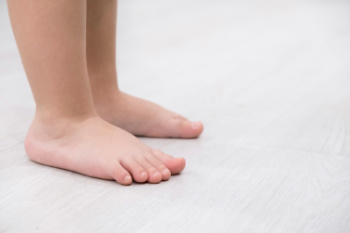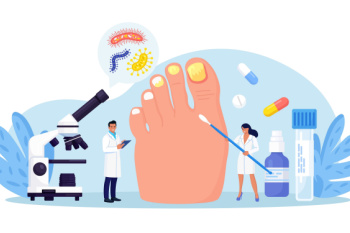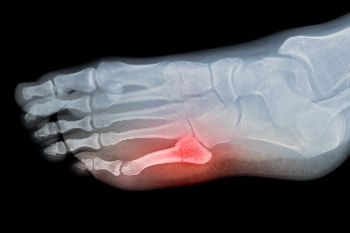Items filtered by date: July 2024
Overpronation and Flat Feet in Children

Pronation, the natural inward roll of the foot during walking or running, varies in children and plays a critical role in their foot development. Normal pronation involves a slight inward movement that helps absorb shock. Underpronation, or supination, occurs when the foot rolls outward excessively, potentially leading to insufficient shock absorption. Conversely, overpronation involves an exaggerated inward roll, which may stress the foot and ankle structures. Arch development is closely linked, as children typically have flat feet at birth, with arches developing as they grow and bear weight. However, some children may retain flat feet or develop high arches, impacting their pronation patterns. Monitoring pronation types and arch development in children is essential for identifying potential issues early on, and promoting proper footwear choices and exercises to support healthy foot development and prevent future complications. If your child’s feet have not developed arches, it is suggested that you consult a podiatrist who can help you monitor this condition.
Flatfoot is a condition many people suffer from. If you have flat feet, contact James P. Huish, DPM from Arizona. Our doctors will treat your foot and ankle needs.
What Are Flat Feet?
Flatfoot is a condition in which the arch of the foot is depressed and the sole of the foot is almost completely in contact with the ground. About 20-30% of the population generally has flat feet because their arches never formed during growth.
Conditions & Problems:
Having flat feet makes it difficult to run or walk because of the stress placed on the ankles.
Alignment – The general alignment of your legs can be disrupted, because the ankles move inward which can cause major discomfort.
Knees – If you have complications with your knees, flat feet can be a contributor to arthritis in that area.
Symptoms
- Pain around the heel or arch area
- Trouble standing on the tip toe
- Swelling around the inside of the ankle
- Flat look to one or both feet
- Having your shoes feel uneven when worn
Treatment
If you are experiencing pain and stress on the foot you may weaken the posterior tibial tendon, which runs around the inside of the ankle.
If you have any questions please feel free to contact our office located in Safford and Sierra Vista, AZ . We offer the newest diagnostic and treatment technologies for all your foot and ankle needs.
What Are the Signs of Toenail Fungus?

Toenail fungus, also known as onychomycosis, is a common condition caused by various fungi that thrive in warm, moist environments. Frequent exposure to such environments, like public swimming pools or showers, can increase the risk of infection. Additionally, wearing tight or non-breathable shoes and having minor skin or nail injuries can also make toenails more susceptible to fungal infections. Symptoms of toenail fungus can include thickened, discolored, or brittle nails that may become distorted in shape. The affected nails may also separate from the nail bed, and a foul odor can develop. In some cases, the surrounding skin may appear red and inflamed. Early detection and treatment are critical to prevent the infection from spreading and causing further complications. Maintaining good foot hygiene and wearing breathable footwear can help reduce the risk of toenail fungus. If you have developed this condition, it is suggested that you contact a podiatrist who can successfully treat it, which most likely will include prescribed medication.
For more information about treatment, contact James P. Huish, DPM of Arizona. Our doctors can provide the care you need to keep you pain-free and on your feet.
Toenail Fungus Treatment
Toenail fungus is a condition that affects many people and can be especially hard to get rid of. Fortunately, there are several methods to go about treating and avoiding it.
Antifungals & Deterrence
Oral antifungal medicine has been shown to be effective in many cases. It is important to consult with a podiatrist to determine the proper regiment for you, or potentially explore other options.
Applying foot powder on the feet and shoes helps keep the feet free of moisture and sweat.
Sandals or open toed shoes – Wearing these will allow air movement and help keep feet dry. They also expose your feet to light, which fungus cannot tolerate. Socks with moisture wicking material also help as well.
If you have any questions please feel free to contact our office located in Safford and Sierra Vista, AZ . We offer the newest diagnostic tools and technology to treat your foot and ankle needs.
Cause of Pain on Top of the Foot

Experiencing pain on the top of the foot is a common issue among runners and active individuals. One cause of this discomfort is extensor tendonitis, an inflammation of the extensor tendons responsible for lifting and straightening the toes. These tendons are vulnerable to injury because they lack protection from bones, muscles, or fatty tissue. Factors that place undue stress on the tendons include tight calf muscles, overtraining without adequate rest, and wearing improperly fitting shoes. Symptoms of extensor tendonitis include pain on the top of the foot during movement, swelling, and sometimes a visible bump along the tendon. Adjusting the way you lace your shoes can help to alleviate pressure on the top of the foot. If pain persists, it may indicate conditions, such as metatarsal stress fractures, atypical gout, or degenerative arthritis. Proper diagnosis from a podiatrist can address the root cause of the pain. If you are experiencing pain on top of the foot, it is suggested that you schedule an appointment with a podiatrist for an exam and treatment options.
Foot Pain
Foot pain can be extremely painful and debilitating. If you have a foot pain, consult with James P. Huish, DPM from Arizona. Our doctors will assess your condition and provide you with quality foot and ankle treatment.
Causes
Foot pain is a very broad condition that could be caused by one or more ailments. The most common include:
- Bunions
- Hammertoes
- Plantar Fasciitis
- Bone Spurs
- Corns
- Tarsal Tunnel Syndrome
- Ingrown Toenails
- Arthritis (such as Gout, Rheumatoid, and Osteoarthritis)
- Flat Feet
- Injury (from stress fractures, broken toe, foot, ankle, Achilles tendon ruptures, and sprains)
- And more
Diagnosis
To figure out the cause of foot pain, podiatrists utilize several different methods. This can range from simple visual inspections and sensation tests to X-rays and MRI scans. Prior medical history, family medical history, and any recent physical traumatic events will all be taken into consideration for a proper diagnosis.
Treatment
Treatment depends upon the cause of the foot pain. Whether it is resting, staying off the foot, or having surgery; podiatrists have a number of treatment options available for foot pain.
If you have any questions, please feel free to contact our office located in Safford and Sierra Vista, AZ . We offer the newest diagnostic and treatment technologies for all your foot care needs.
Common Foot Problems in Aging Feet
 Foot care among the elderly is essential to lessen the effects of common problems that can significantly impact mobility and comfort. These can include osteoarthritis, which causes joint pain, stiffness, and swelling, making it difficult to walk. Peripheral artery disease, or PAD, leads to poor circulation, resulting in leg pain, cramping, and slow-healing sores. Neuropathy, often associated with diabetes, causes numbness, tingling, and burning sensations, increasing the risk of unnoticed injuries. Plantar fasciitis is characterized by sharp heel pain, especially in the morning or after long periods of rest. Additionally, Achilles tendonitis causes pain and stiffness along the back of the heel, often worsening with activity. These conditions highlight the importance of regular foot care, wearing appropriate footwear, and medical attention to manage symptoms and maintain foot health in older adults. If you are elderly and are experiencing any type of foot discomfort, it is suggested that you schedule an appointment with a podiatrist who can offer you appropriate treatment methods.
Foot care among the elderly is essential to lessen the effects of common problems that can significantly impact mobility and comfort. These can include osteoarthritis, which causes joint pain, stiffness, and swelling, making it difficult to walk. Peripheral artery disease, or PAD, leads to poor circulation, resulting in leg pain, cramping, and slow-healing sores. Neuropathy, often associated with diabetes, causes numbness, tingling, and burning sensations, increasing the risk of unnoticed injuries. Plantar fasciitis is characterized by sharp heel pain, especially in the morning or after long periods of rest. Additionally, Achilles tendonitis causes pain and stiffness along the back of the heel, often worsening with activity. These conditions highlight the importance of regular foot care, wearing appropriate footwear, and medical attention to manage symptoms and maintain foot health in older adults. If you are elderly and are experiencing any type of foot discomfort, it is suggested that you schedule an appointment with a podiatrist who can offer you appropriate treatment methods.
Proper foot care is something many older adults forget to consider. If you have any concerns about your feet and ankles, contact James P. Huish, DPM from Arizona. Our doctors can provide the care you need to keep you pain-free and on your feet.
The Elderly and Their Feet
As we age we start to notice many changes in our body, but the elder population may not notice them right away. Medical conditions may prevent the elderly to take notice of their foot health right away. Poor vision is a lead contributor to not taking action for the elderly.
Common Conditions
- Neuropathy – can reduce feeling in the feet and can hide many life-threatening medical conditions.
- Reduced flexibility – prevents the ability of proper toenail trimming, and foot cleaning. If left untreated, it may lead to further medical issues.
- Foot sores – amongst the older population can be serious before they are discovered. Some of the problematic conditions they may face are:
- Gouging toenails affecting nearby toe
- Shoes that don’t fit properly
- Pressure sores
- Loss of circulation in legs & feet
- Edema & swelling of feet and ankles
Susceptible Infections
Diabetes and poor circulation can cause general loss of sensitivity over the years, turning a simple cut into a serious issue.
If you have any questions please feel free to contact our office located in Safford and Sierra Vista, AZ . We offer the newest diagnostic and treatment technologies for all your foot and ankle needs.
Are Bunions Affecting Your Everyday Life?
Recognizing Common Symptoms of a Broken Foot

A broken foot can present with several clear symptoms, and it is vital to identify them for prompt treatment. One of the most telling signs is a sharp, severe pain that often worsens with movement or weight-bearing activities. A sensation of dislocated bones, where the foot feels misaligned or abnormal, is also common. Swelling and bruising typically develop rapidly around the affected area, indicating internal bleeding and inflammation. Visible deformities or an inability to move the foot or toes may also occur, in addition to a pronounced tenderness when touching the injured area. Treatment may include immobilization with a cast, use of crutches, and in severe cases, surgical intervention to realign the broken bones. If you feel you may have broken your foot, it is suggested that you consult a podiatrist who can accurately diagnose it and treat it accordingly.
A broken foot requires immediate medical attention and treatment. If you need your feet checked, contact James P. Huish, DPM from Arizona. Our doctors can provide the care you need to keep you pain-free and on your feet.
Broken Foot Causes, Symptoms, and Treatment
A broken foot is caused by one of the bones in the foot typically breaking when bended, crushed, or stretched beyond its natural capabilities. Usually the location of the fracture indicates how the break occurred, whether it was through an object, fall, or any other type of injury.
Common Symptoms of Broken Feet:
- Bruising
- Pain
- Redness
- Swelling
- Blue in color
- Numbness
- Cold
- Misshapen
- Cuts
- Deformities
Those that suspect they have a broken foot shoot seek urgent medical attention where a medical professional could diagnose the severity.
Treatment for broken bones varies depending on the cause, severity and location. Some will require the use of splints, casts or crutches while others could even involve surgery to repair the broken bones. Personal care includes the use of ice and keeping the foot stabilized and elevated.
If you have any questions please feel free to contact our office located in Safford and Sierra Vista, AZ . We offer the newest diagnostic and treatment technologies for all your foot and ankle needs.

